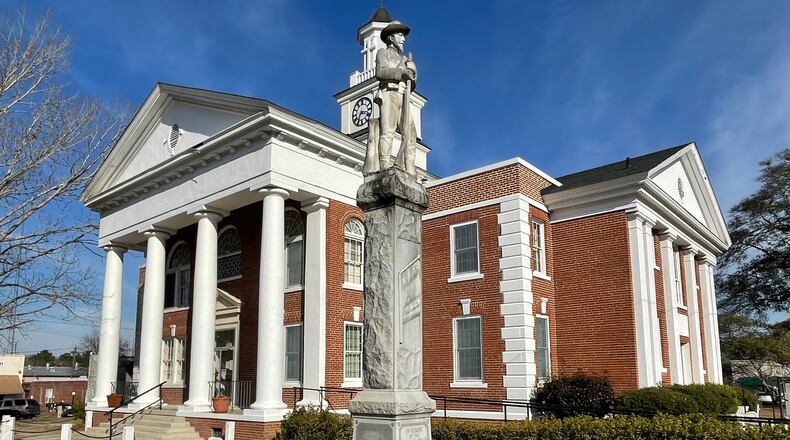At a busy intersection in Druid Hills, hundreds of motorists whiz by a memorial to Confederate States President Jefferson Davis without knowing it, but it’s a reminder of how ever-present such monuments are in Georgia.
At about 18 inches tall, the granite block barely peeks out from behind a small azalea at the intersection of Ponce De Leon Avenue and East Lake Drive. Its century-old engraving reads, “Jefferson Davis Highway GA.”
The marker is one of 285 markers, memorials, monuments and place names honoring the Confederacy dotting the roadways, cemeteries and courthouse lawns across Georgia, according to the Southern Poverty Law Center. The Alabama-based hate group watchdog Tuesday released its third edition of its census of more than 2,000 Confederate memorials with a renewed call they be removed.
“The legacy of the Confederacy is far more enduring than any memorial ever could be,” said Kimberly Probolus, a fellow with the Southern Poverty Law Center’s Intelligence Project. “Destroying these monuments and memorials will not erase the legacy of slavery, but abolishing these memorials is a first and essential step in combating the white supremacy values of the Confederacy.”
While the report records memorials to the Confederacy in nearly every state (New York has seven), most of the targeted items on the center’s list are concentrated in the states that made up the old Confederacy. Of those, only Virginia, with 290, has more than Georgia.
While the group’s list is incomplete, it includes 44 schools in Georgia named for Confederate icons, including Wheeler High School in Cobb County, named for Gen. Joseph Wheeler; and several schools named for the Southern poet Sidney Lanier, who served in the Confederate Army as a private and later as a blockade runner.
It also includes the 17,000-square-foot carving on the face of Stone Mountain.
“The landscape of the South is just saturated with it,” University of North Carolina at Charlotte historian Karen Cox said.
Credit: Chris Joyner
Credit: Chris Joyner
Cox has spent decades researching and writing about the campaign to erect monuments to the Confederacy in the decades following Reconstruction.
“There was hardly a thing that was not marked, memorialized, renamed — it just goes on,” she said.
The creation of all of those memorials was championed largely by the United Daughters of the Confederacy and came as Southern whites reasserted their political dominance, stripping Blacks of their rights and instituting a legal system of segregation that would take a half a century to dismantle.
The monuments themselves have proven more durable, with many a century or more into their lifespans. This year, the equestrian statue of Gov. John B. Gordon, a Confederate general and early leader of the Ku Klux Klan, will mark 115 years on the grounds of the State Capitol despite calls from some of Gordon’s own descendants to have it removed.
Calls to remove Confederate symbols from public lands spiked following the 2015 massacre of nine Black church goers in Charleston by a white supremacist. Many state governments, including the Georgia Legislature, responded by making it more difficult to displace them, with opponents to removals blasting the effort as trying to “erase history.”
In 2019, the Georgia Legislature passed a law making it difficult for local governments to remove monuments and increased the criminal penalties for anyone caught vandalizing them.
Rep. Alan Powell, who supported the bill, said the issue has become “too politicized,” and the monuments have nothing to do with white supremacy or honoring the Southern history of slavery.
“Slavery was a cruel institution, but it was there because the South was an agrarian society and we did not have the mechanisms we have now for agriculture,” Powell said. “It was what it was and it wasn’t just here in the South.”
“Most of these monuments were erected by the widows of the men who died for the Confederacy on the battlefield,” said the Hartwell Republican. “At the end of the day, it is about trying to erase history.”
Nonetheless, some localities have managed to take them down.
Probolus said six symbols were removed in Georgia in 2021.
“It is very clear that with states with preservation laws, it is tough to have removals,” Probolus said.
In 2020, a DeKalb County judge declared a 30-foot Confederate obelisk on the Decatur Square to be a “public nuisance” and ordered it removed and placed in storage. Officials in Henry County quickly followed suit, ordering the removal of a century-old statue of a Confederate soldier from the McDonough town square.
Last year, the Gwinnett County Board of Commissioners voted to have a granite monument to the county’s Confederate soldiers removed, ostensibly to protect it from vandals.
Nationally, the most prominent removal came in September when a gigantic statue of Gen. Robert E. Lee on horseback was taken down from its place on Monument Avenue in Richmond, Va., the former capital of the Confederacy. According to the report, more than 375 monuments have been taken down across the country.
In Georgia, some of the names are beginning to be replaced with less divisive heroes. Last year, the Atlanta Board of Education voted unanimously to rename Forrest Hill Academy, which had been named after Confederate general and Ku Klux Klan leader Nathan Bedford Forrest, for the late baseball great Hank Aaron.
However, Cox said the pace of removals has slowed. She said, upticks in calls for removal generally come on the heels of a crisis, such as the white supremacist-led Unite the Right Rally in Charlottesville in 2017 and the murder of George Floyd by a white policeman in 2020.
“It’s been quiet,” Cox said.
She said the issues underlying the monument debate — racial justice and equity — have spawned their own reaction, as conservatives bang the drum over “Critical Race Theory.”
“They are coming after people just for teaching about race,” she said. “It’s an opportunity to sanitize history, and in some ways that’s what these monuments represent. ... It’s a reminder to stay in your place.”
Keep Reading
The Latest
Featured





